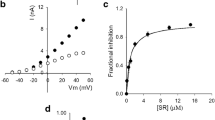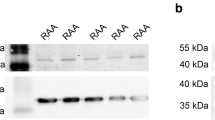Abstract
The ectopic overexpression of the voltage-dependent Eag1 (Kv10.1) K+ channel is associated with the cancerous phenotype in about 70% of human cancers and tumor cell lines. Recent reports showed that, compared with the canonical Shaker-related Kv family, Kv10.1 presents unique structural and functional properties. Herein, we report the interaction of the class III anti-arrhythmic compound amiodarone with Kv10.1. Using whole-cell patch clamp, we found that amiodarone inhibits Kv10.1 channel conductance with nanomolar affinity. Additionally, and interestingly, we also report that amiodarone inhibits the characteristic Cole-Moore shift of Eag1 channels. Our observations are interpreted considering the structural-functional characteristics of these channels. We conclude that amiodarone possibly binds with high affinity to the voltage sensor module, altering the gating of Kv10.1.








Similar content being viewed by others
Change history
16 March 2018
The original publication of this article contained multiple technical errors that occurred during its production and printing. These errors included sentences and paragraphs with parts missing. The Publisher regrets these mistakes.
References
Armstrong CM (1971) Interaction of tetraethylammonium ion derivatives with the potassium channels of giant axons. J Gen Physiol 58(4):413–437. https://doi.org/10.1085/jgp.58.4.413
Balser JR, Bennett PB, Hondeghem LM, Roden DM (1991) Suppression of time-dependent outward current in guinea pig ventricular myocytes. Actions of quinidine amiodarone. Circ Res, 69(2):519–529
Bauer CK, Schwarz JR (2001) Physiology of EAG K+ channels. J Membrane Biol 182:1–15
Cole KS, Moore JW (1960) Potassium ion current in the squid giant axon: dynamic characteristics. Biophys J 1(1):1–14. https://doi.org/10.1016/S0006-3495(60)86871-3
Cornish-Bowden A (2014) Fundamentals of enzyme kinetics. Fourth edition. Wiley-Blackwell
Downie BR, Sánchez A, Knötgen H, Contreras-Jurado C, Gymnopoulos M, Weber C, Stühmer W, Pardo LA (2008) Eag1 expression interferes with hypoxia homeostasis and induces angiogenesis in tumors. J Biol Chem 283(52):36234–36240. https://doi.org/10.1074/jbc.M801830200
Doyle DA, Morais Cabral J, Pfuetzner RA, Kuo A, Gulbis JM, Cohen SL, Chait BT, MacKinnon R (1998) The structure of the potassium channel: molecular basis of K+ conduction and selectivity. Science 280(5360):69–77. https://doi.org/10.1126/science.280.5360.69
Gagnon DG, Bezanilla F (2009) A single charged voltage sensor is capable of gating the Shaker K+ channel. J Gen Physiol 133(5):467–483. https://doi.org/10.1085/jgp.200810082
Garg V, Sachse FB, Sanguinetti MC (2012) Tunning of EAG K+ channel inactivation: molecular determinants of amplification by mutations and small molecules. J Gen Physiol 140:307–324
Gómez-Lagunas F, Carrillo E, Pardo LA, Stühmer W (2017) Gating modulation of the tumor-related Kv10.1 channel by Mibefradil. J Cell Physiol 232(8):2019–2032. https://doi.org/10.1002/jcp.25448
Gómez-Lagunas F, Barriga-Montoya C (2017) Mibefradil inhibition of the Cole-Moore shift and K+-conductance of the tumor-related Kv10.1 channel. Channels (Austin) 26:1–4
Hegle AP, Marble DD, Wilson GF (2006) A voltage-driven switch for ion-independent signaling by ether-a-go-go K+ channels. Proc Natl Acad Sci U S A 103(8):2886–2891. https://doi.org/10.1073/pnas.0505909103
Holmgren M, Smith PL, Yellen G (1997) Trap** of organic blockers by closing of voltage-dependent K+ channels. Evidence for a trap door mechanism of activation kinetics. J Gen Physiol 109:527–535
Hoshi T, Armstrong CM (2015) The Cole-Moore shift still unexplained?. Biophys J 109:1312–1316, 7, DOI: https://doi.org/10.1016/j.bpj.2015.07.052
Ju M, Wray D (2006) Molecular regions responsible for differences in activation between heag channels. Biochem Biophys Res Commun 342(4):1088–1097. https://doi.org/10.1016/j.bbrc.2006.02.062
Kamiya K, Atsushi N, Yasui K, Hojo M, Sanguinetti MC, Kodama I (2001) Short- and long-term effects of amiodarone on the two components of cardiac delayed rectifier K+ current. Circulation 103(9):1317–1324. https://doi.org/10.1161/01.CIR.103.9.1317
Kodama I, Kamiya K, Toyama J (1997) Cellular electropharmacology of amiodarone. Cardiovasc Res 35:13–29, 1, DOI: https://doi.org/10.1016/S0008-6363(97)00114-4
Long SB, Campbell EB, MacKinnon R (2005) Crystal structure of a mammalian voltage-dependent Shaker family K+ channel. Science 309:897–903, 5736, DOI: https://doi.org/10.1126/science.1116269
Loewe A, Lutz Y, Wilhelms M, Sinnecker D, Barthel P, Scholz EP, Dössel O, Schmidt G, Seemann G (2014) In silico assessment of the dynamic effects of amiodarone and dronedarone on human atrial patho-electrophysiology. Europace 16:iv30–iv38
Lörinczi É, Gómez-Posada JC, de la Peña P, Tomczak AP, Fernández-Trillo J, Leipscher U, Stühmer W, Barros F, Pardo LA (2015) Voltage-dependent gating of KCNH potassium channels lacking a covalent link between voltage-sensing and pore domains. Nat Commun 6:6672. https://doi.org/10.1038/ncomms7672
Morais Cabral JH, Lee A, Cohen SL, Chait BT, Li M, MacKinnon R (1998) Crystal structure and functional analysis of the HERG potassium channel N terminus: a eukaryotic PAS domain. Cell 95(5):649–655. https://doi.org/10.1016/S0092-8674(00)81635-9
Occhiodoro T, Bernheim L, Liu JH, Bijlenga P, Sinnreich M, Bader CR, Fischer-Lougheed J (1998) Cloning of a human ether-à-go-go potassium channel expressed in myoblasts at the onset of fusion. FEBS Lett 434:177–182, 1-2, DOI: https://doi.org/10.1016/S0014-5793(98)00973-9
Ouadid-Ahidouch H, Ahidouch A, Pardo LA (2016) Kv10.1 K+ channel: from physiology to cancer. Pflugers Arch-Eur J Physiol 468:751–762
L A Pardo, D del Camino, A Sánchez, F Alves, A Brüggemann, S Beckh, and W Stühmer (1999) Oncogenic potential of EAG channels. EMBO J 18:5540–5547, 20, DOI: https://doi.org/10.1093/emboj/18.20.5540
Pardo L. A., Stühmer W. (2014) The role of K+ channels in cancer. Nat Rev Cancer 14:39–48, 1, DOI: https://doi.org/10.1038/nrc3635
Peña A, Calahorra C, Michel B, Ramírez J, Sánchez NS (2009) Effects of amiodarone on K+, inaternal pH and Ca2+ homeostasis in Saccharomyces cerevisiae. FEMS Yeast Res 9(6):832–848. https://doi.org/10.1111/j.1567-1364.2009.00538.x
Sato T, Takizawa T, Saito T, Kobayashi S, Hara Y, Nakaya H (2003) Amiodarone inhibits sarcolemmal but not mitochondrial KATP channels in guinea pig ventricular cells. J Pharmacol Exp Ther 307(3):955–960. https://doi.org/10.1124/jpet.103.055863
Schönherr R, Mannuzzu L, Isacoff EY, Heinemann S (2002) Conformational switch between slow and fast gating modes: allosteric regulation of voltage sensor movility in the eag K+ channel. Neuron 35(935–949):5. https://doi.org/10.1016/S0896-6273(02)00869-3
Silverman WR, Roux B, Papazian DM (2003) Structural basis of two-stage voltage-dependent activation in K+ channels. Proc Natl Acad Sci U S A 100(5):2935–2940. https://doi.org/10.1073/pnas.0636603100
Tamargo J, Caballero R, Gómez R, Valenzuela C, Delpón E (2004) Pharmacology of cardiac potassium channels. Cardiovasc Res 62:9–33, 1, DOI: https://doi.org/10.1016/j.cardiores.2003.12.026
Tang CY, Bezanilla F, Papazian DM (2000) Extracellular Mg2+ modulates slow gating transitions and the opening of ether-a-go-go potassium channels. J Gen Physiol 115(3):319–337. https://doi.org/10.1085/jgp.115.3.319
Terlau H, Ludwig J, Steffan R, Pongs O, Stngsan W, Heinemann SH (1996) Extracellular Mg2+ regulates activation of rat eag potassium channel. Pflugers Arch 432(2):301–312. https://doi.org/10.1007/s004240050137
Terlau H, Heinemann S, Stuhmer W, Pongs O, Ludwig J (1997) Amino terminal-dependent gating of the potassium channel rat eag is compensated by a mutation in the S4-segment. J Physiol 502(3):537–543. https://doi.org/10.1111/j.1469-7793.1997.537bj.x
Ting-Feng L, Guey-Mei J, Hsin-Yu F, Ssu-Ju F, Hao-Han W, Mei-Miao C, Chung-Jiuan J (2014) The Eag domain regulates the voltage-dependent inactivation of rat Eag1 K+ channels. PLoS One 9:e110423
Tomczak A, Fernández-Trillo J, Bharill S, Papp F, Panyi G, Stühmer W, Isacoff EY, Pardo AL (2017) A new mechanism of voltage-dependent gating exposed by Kv10.1 channels interrupted between voltage sensor and pore. J Gen Physiol 30:577–593
Turker I, Yu C-C, Chang P-C, Chen Z, Sohma Y, Lin S-F, Chen PS, Ai T (2013) Amiodarone inhibits apamin-sensitive potassium currents. PLoS One 8(7):e70450. https://doi.org/10.1371/journal.pone.0070450
Waldhauser KM, Brecht K, Hebeisen S, Ha HR, Konrad D, Bur D, Krrradener S (2008) Interaction with the hERG channel and cytotoxicity of amiodarone and amiodarone analogs. Br J Pharmacol 155:585–595
Warmke JW, Ganetzky B (1994) A family of potassium channel genes related to eag in Drosophila and mammals. Proc Natl Acad Sci U S A 91:3438–3442, 8, DOI: https://doi.org/10.1073/pnas.91.8.3438
Wei A, Jegla T, Salkoff L (1996) Eight potassium channel families revealed by the C. elegans genome proyect. Neuropharmacology 35(7):805–829. https://doi.org/10.1016/0028-3908(96)00126-8
Whicher J, MacKinnon R (2016) Structure of the voltage-gated K+ channel Eag1 reveals an alternative voltage sensing mechanism. Science 353(6300):664–669. https://doi.org/10.1126/science.aaf8070
Wu L, Rajamani S, Shryock JC, Li H, Ruskin J, Antzelevitch C, Belardinelli L (2008) Augmentation of late sodium current unmasks the proarrythmic effects of amiodarone. Cardiovasc Res. 77:481–488
Yang M, Brackenbury WJ (2013) Membrane potential and cancer progression. Front Physiol 4,185, DOI: https://doi.org/10.3389/fphys.2013.00185
Zagotta WN, Hoshi T, Aldrich RW (1994) Shaker potassium channel gating III. Evaluation of kinetic models for activation. J Gen Physiol 103:321–362
Acknowledgements
The authors thank Dr. Daniel Balleza for his participation in the initial phase of this work and to Mrs. Josefina Bolado of the School of Medicine, UNAM, for reviewing the English language of the manuscript.
Funding
This research was supported by PAPIIT grants IN22461-RN22461 and IN219918 grants from CONACyT Laboratorios Nacionales Consolidaci461-RN224616, for reviewin05 and 153504, and PAPIIT IN211616 and IN220916. AHG is a DGAPA-UNAM postdoctoral fellow.
Author information
Authors and Affiliations
Contributions
CBM, AHG ARV, AHC, and AP made experiments and contributed to the analysis of results; FGL designed the work, made experiments, analyzed results and wrote the article.
Corresponding author
Ethics declarations
Conflict of interest
The authors declare that they have no conflicts of interest.
Additional information
A correction to this article is available online at https://doi.org/10.1007/s00424-018-2131-2.
Electronic supplementary material
Supplementary Figure 1
A test for inactivation of control, unmodified, Kv10.1 channels. Non-inactivated current fraction vs. pre-pulse voltage (H616, for revi3 independent experiments carried out with non-modified, control, Kv10.1 channels. I K was evoked by a constant + 50 mV/0.1 s pulse following 1-s pre pulses from −140 to +50 mV, applied in 10 mV increments, as indicated. The non-inactivated fraction was obtained as I K(+50 mV)/I K,max, as a function of pre-pulse potential. See that at any voltage, I K drops less than 10% (for some voltages current drop is even less than 5%). Pair of pulses were applied every 20 sec. (GIF 124 kb)
Rights and permissions
About this article
Cite this article
Barriga-Montoya, C., Huanosta-Gutiérrez, A., Reyes-Vaca, A. et al. Inhibition of the K+ conductance and Cole-Moore shift of the oncogenic Kv10.1 channel by amiodarone. Pflugers Arch - Eur J Physiol 470, 491–503 (2018). https://doi.org/10.1007/s00424-017-2092-x
Received:
Revised:
Accepted:
Published:
Issue Date:
DOI: https://doi.org/10.1007/s00424-017-2092-x




